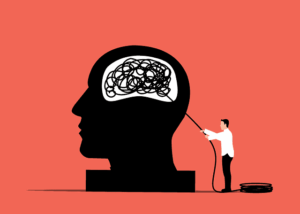Are you or someone you know struggling with Attention Deficit Hyperactivity Disorder (ADHD)? Have traditional treatments not been effective? Look no further than Eye Movement Desensitization and Reprocessing (EMDR) therapy. This innovative technique may seem unconventional, but it has shown promising results in improving ADHD symptoms. In this blog post, we’ll explore the ins and outs of EMDR for ADHD and why it could be a game-changer for those seeking relief from their symptoms.
Contents
What is EMDR?

Eye Movement Desensitization and Reprocessing (EMDR) is a type of therapy that helps people heal from trauma. It is a powerful and effective treatment for post-traumatic stress disorder (PTSD) and is helpful for other mental health conditions such as anxiety, depression, and phobias.
EMDR therapy uses a combination of eye movements and bilateral stimulation (usually tapping or buzzing) to help the brain process and heal from trauma. The therapist will guide you through the process, helping you to focus on specific memories or thoughts while you move your eyes back and forth. The bilateral stimulation helps to calm the nervous system and allows the brain to process memories or thoughts more.
EMDR therapy is usually done in 8-12 sessions, although some people may need more or less depending on their individual needs. It is important to find a therapist who is trained in EMDR therapy, as it requires specific training and experience to do it effectively.
How Does EMDR Work for ADHD?
EMDR works by targeting and processing past traumatic experiences that may be contributing to current symptoms. During an EMDR session, the therapist guides the client through a series of eye movements or other bilateral stimulation while they focus on a distressing memory or experience. The goal is to help the client process the memory in a new and adaptive way, which can reduce the emotional and physiological distress associated with the memory.
Research on the use of EMDR for ADHD is limited, but some studies have shown promising results. One study found that EMDR was effective in reducing ADHD symptoms in children and adolescents who had experienced trauma. Another study found that EMDR was effective in reducing ADHD symptoms in adults who had experienced childhood trauma.
EMDR therapy involves having the person sit in a comfortable chair and focus on a specific memory or event while the therapist moves their eyes back and forth. The therapist will also ask the person to keep track of their thoughts and feelings during the session. EMDR can help people with ADHD to process memories and events that may be causing them distress. This type of therapy can also help people to learn new coping skills and ways of dealing with difficult situations.
Techniques of EMDR For ADHD

EMDR (Eye Movement Desensitization and Reprocessing) is a psychotherapy approach that involves a standardized eight-phase protocol. Here are some techniques that may be used in EMDR for ADHD:
- Resource development: Before starting the reprocessing phase of EMDR, the therapist may work with the individual to develop internal resources, such as a sense of safety, confidence, and calm. These resources can be used during the reprocessing phase to help the individual better manage emotional dysregulation and impulsivity.
- Cognitive interweave: During the reprocessing phase, the therapist may use cognitive interweaves to address negative self-beliefs or cognitive distortions that may be contributing to ADHD symptoms. For example, the therapist may ask the individual to consider an alternative belief or perspective that is more adaptive and positive.
- Targeting specific memories: While EMDR is not typically used to address ADHD symptoms directly, the therapist may target specific memories or experiences that are contributing to emotional dysregulation or impulsivity. For example, the therapist may target the memory of a particularly traumatic or emotionally challenging experience that is causing emotional distress or interfering with attention and focus.
- Incorporating physical movement: In some cases, the therapist may incorporate physical movement, such as tapping or eye movements, during the reprocessing phase to help the individual better integrate the sensory and emotional components of the targeted memory.
Benefits of EMDR for ADHD
Some research suggests that it may help reduce ADHD symptoms in some individuals. Here are some potential benefits of EMDR for ADHD:
- Reducing the impact of past trauma: EMDR is thought to be effective in reducing the emotional and physiological distress associated with past traumatic experiences. By reducing the impact of past trauma, individuals may be better able to focus, regulate their emotions, and manage impulsivity and hyperactivity.
- Improving emotional regulation: EMDR can help individuals develop more adaptive coping skills and strategies for managing their emotions, which can be helpful for individuals with ADHD who may struggle with emotional dysregulation.
- Enhancing self-esteem: EMDR can help individuals develop a more positive sense of self and increase their self-esteem, which can be helpful for individuals with ADHD who may struggle with feelings of inadequacy or low self-worth.
- Improving overall mental health: By reducing symptoms of anxiety, depression, and other mental health conditions that commonly co-occur with ADHD, EMDR can improve overall mental health and well-being.
Risks Associated With EMDR for ADHD

However, like any psychotherapy approach, there are potential risks associated with EMDR.
- One potential risk of EMDR is that it can be emotionally intense, as the therapy involves revisiting traumatic experiences and processing the associated emotions. This can be difficult for some individuals and may trigger feelings of distress, anxiety, or even a temporary increase in ADHD symptoms.
- Another potential risk of EMDR is that it may not be effective for everyone. While EMDR is effective for many people, it may not work for everyone, and some individuals may require additional or alternative treatments to manage their ADHD symptoms.
- It’s also important to note that EMDR should not be used as a sole treatment for ADHD, and should be used in conjunction with other evidence-based treatments, such as medication and behavioral therapy. Individuals should work with their healthcare providers to develop a comprehensive treatment plan that meets their individual needs and goals.
Overall, the potential risks associated with EMDR for ADHD are generally low, and many individuals find the therapy to be a helpful and effective tool for managing their symptoms.
How Can I Find a Qualified Practitioner?

If you’re interested in trying EMDR (Eye Movement Desensitization and Reprocessing) for ADHD or any other mental health concern, it’s important to work with a qualified practitioner who has training and experience in this type of therapy. Here are some steps you can take to find a qualified EMDR practitioner:
- Check for credentials: Look for a therapist who is licensed in your state or province and who has completed training in EMDR from a reputable organization. You can also visit websites like Mantracare and Therapymantra for therapists.
- Ask for referrals: Talk to your healthcare provider or mental health professional for recommendations. You can also ask friends, family members, or support groups for referrals.
- Research online: Search for EMDR practitioners in your area and read reviews from previous clients. You can also check the therapist’s website to learn more about their training and experience.
- Interview potential therapists: Once you’ve found a few potential therapists, schedule a consultation to learn more about their approach and experience with EMDR. Ask about their training and certification, as well as their experience working with individuals with ADHD or other mental health concerns.
- Trust your instincts: Ultimately, it’s important to work with a therapist who you feel comfortable with and who you trust. If you don’t feel a connection with a particular therapist, it’s okay to keep searching until you find someone who feels like the right fit.
Conclusion
In conclusion, EMDR is a great technique to help those with ADHD in managing their symptoms and develop more coping mechanisms for everyday life. It can be incredibly effective when used correctly, however, anyone considering using this approach must do so under the guidance of a professional therapist or clinician who specializes in such treatment. If you are struggling with ADHD and feel like EMDR could be something to try, then take your time researching local professionals and seeing if this is an appropriate solution for you.
For more information, please contact MantraCare. ADHD is a neurodevelopmental disorder characterized by difficulty paying attention, hyperactivity, and impulsivity. If you have any queries regarding Online ADHD Counseling experienced therapists at MantraCare can help: Book a trial ADHD therapy session


